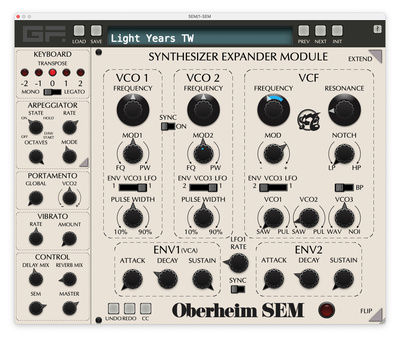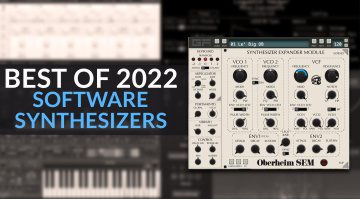Best Software Synths of 2022: Classic recreations & Innovative Weirdness!
What were the best software synths of 2022? We were treated to a lot of recreations of classic synths to satisfy our love of nostalgic sounds. Equally, we were also greeted with some weird and wonderful software synths delivering us new and interesting sounds and textures. Here are my picks of the year’s best and most interesting soft synths…
Software synthesizers, VSTis, virtual synths or however you like to describe them, have an opportunity to innovate beyond the scale of hardware. They can do unimaginable things and unlock an amazing amount of creativity within our computers and DAWs. But this year appears to be dominated by homages and emulations of synths long past. All have been beautifully captured to offer us access to the sound of hardware most of us could never own. So, while I look for innovation, I also like to wallow in nostalgia, and there’s no reason why we can’t enjoy both.
Gforce Oberheim SEM
GForce software did some great work this year. They kicked it off by revitalising the M-Tron emulation and then reworked the Oberheim OB-E 8-voice emulation to sound so fantastic that Tom Oberheim gave it his seal of approval. The Oddity, the emulation of the ARP Odyssey, also got a long overdue update. But it was the SEM that hit the mark for me.
The Oberheim SEM emulation pulls one of those creamy-looking monosynths out of the OB-E 8-Voice. It gives you the most perfectly authentic Oberheim-sounding monosynth experience you can possibly have. It’s just lovely. Those two VCOs playing delightfully against each other and then oozing through the 12dB filter has a classic vintage vibe. Gforce has added a third modulating oscillator, modulation routings, an arpeggiator and some lovely effects to turn it into a very playable, standalone synthesizer.
The SEM is a wonderful synth with some superb and inspiring presets, and you can even load them into the OB-E if you want to go the whole 8-SEM hog.


You are currently viewing a placeholder content from YouTube. To access the actual content, click the button below. Please note that doing so will share data with third-party providers.
Cherry Audio GX-80
Cherry Audio also released some amazing software synths this year. We had the Dreamsynth tribute to the 1980s hybrids, then a very simple and classic Minimode take on the Minimoog. That was followed up by the slightly strange Lowdown Taurus emulation and the superb and unusual Elka-X. The Sines synth was probably the most innovative release this year with its wobbly waves, layers of tones and folded timbres, and that should probably get the nod, but I can’t help myself; I have to declare that the GX-80 is one of the best synths ever created.
The GX-80 is an emulation of the classic Yamaha CS-80 combined with elements from the even more classic GX-1. It’s a huge chunk of a synthesizer with unfamiliar labels, strange controls and dated interfaces, but gee whiz, this thing sounds amazing! You can spend hours absorbing the superb presets before having to touch anything.
The interface will take some getting used to. There are strange envelope elements and uncommon waveform mixing that can be a bit confusing. But it rewards you as you delve into the mechanics and beauty of it all. The ribbon controller, the weird paddles that bring in different expressions and the split/layered nature of the sound engine all combine into a very playable and performable instrument.


You are currently viewing a placeholder content from YouTube. To access the actual content, click the button below. Please note that doing so will share data with third-party providers.
Korg Opsix
The Wavestate, Modwave and Opsix synthesizers didn’t try to hide their software origins. Every time you turned one on you witnessed the synth booting some kind of internal computer into life. So it came as no surprise when first the Wavestate and Opsix and then, just recently, the Modwave appeared as VST synths. While each one is excellent, it’s the Opsix for me that excels by taking on that tricky FM synthesis business and turning it into a fresh and playable instrument.
Opsix is a modern and streamlined approach to FM synthesis. It has a Native Instruments feel to the interface with very clear and defined zones and parameters. And what immediately strikes you is the sight of those 6 sine waves. These are the 6 operators from which you build your algorithms. But it’s not just that. You can also bend these waveforms, shape them, and blend them in additive and subtractive ways. The filter section shines, and the modulation options transport into unexpected places. While all the time, it has the heart of a very cool FM synth. I’ve never found FM as easy or as enjoyable.
You are currently viewing a placeholder content from YouTube. To access the actual content, click the button below. Please note that doing so will share data with third-party providers.
Noise Engineering Plugin Bundle 2
We had two bundles of plugins from Noise Engineering this year. Bundle 1 took in some percussion, a synth and a weird reverb, but it was Bundle 2 that really blew my mind with software versions of the Loquelic Vereor and Mani Iteritas.
These are synths unlike any other. They are pulled out of the Eurorack modules of the same remarkable names and bring a completely odd sensibility to DAW-based synthesis. There’s nothing obvious here; this is all new and exciting territory that’s a lot of fun to explore.
Loquelic Vereor is a complex oscillator that munches on three different synthesis algorithms. These are phase modulation, summation and VOSIM, and there’s no way you’ve heard of all three. It self-modulates and crashes into itself in alarming and fabulous ways and will pierce through the mush of any track. It is nuts.
You are currently viewing a placeholder content from YouTube. To access the actual content, click the button below. Please note that doing so will share data with third-party providers.
Mani Iteritas is thankfully a bit simpler with familiar terms such as additive, subtractive and FM synthesis. It uses saw waves and moves and shapes itself into the most remarkable sounds.
You are currently viewing a placeholder content from YouTube. To access the actual content, click the button below. Please note that doing so will share data with third-party providers.
The bundle also comes with Imitor, an experimental delay plugin which can make anything sound interesting. Together you have a bunch of extraordinary synths that sound like nothing else and take you out of your comfort zone.
Klevgrand Tomofon
Turning up quite quietly at the end of the year was Tomofon from Klevgrand. It’s called the Real Audio Synth and is the most innovative software instrument I’ve seen all year. Tomofon is all about wavetables, although it feels very much like a sampler, and in truth, it’s probably a mix of the two along with a load of stuff I haven’t thought of. It generates sound by extracting and structuring thousands of waves from audio files. So I guess it turns samples into wavetables.
Tomofon then builds an instrument out of oscillating waveforms, which are mapped to pitch zones. The synth engine can then morph between the zones, from waveform to waveform. This gives note transition a whole new level of authenticity. It’s enormously expressive and full of dynamic responses to your playing. It’s capable of quite breathtaking realism as well as curious and interesting synthesis that loves to move.
Things get even more interesting when you start to import your own audio files. Tomofon can automatically do its business or you can get to work distributing content. The interface is nicely designed, as all Klevgrand ones are, with not too much business on the front end and key synthesis elements hidden under tabs. Wonderfully animated dots leap about the place to show you what’s happening – it’s an absolute joy to play.
There are some of the nicest sounds I’ve heard all year rolled up in a deeply interesting synth.
You are currently viewing a placeholder content from YouTube. To access the actual content, click the button below. Please note that doing so will share data with third-party providers.
One response to “Best Software Synths of 2022: Classic recreations & Innovative Weirdness!”

 4,5 / 5,0 |
4,5 / 5,0 | 









My surprise was PECS from FBM. I think that he has absorbed all the best from FBM. And he became such a workhorse. And I think KULT will become a cult